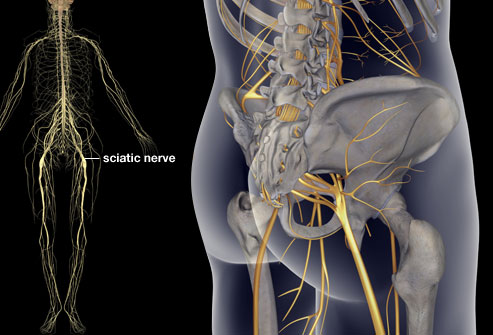 Sciatica refers to back pain caused by a problem with the sciatic nerve. This is a large nerve that runs from the lower back down the back of each leg. When something injures or puts pressure on the sciatic nerve, it can cause pain in the lower back that spreads to the hip, buttocks, and leg. Up to 90% of people recover without surgery.
Sciatica refers to back pain caused by a problem with the sciatic nerve. This is a large nerve that runs from the lower back down the back of each leg. When something injures or puts pressure on the sciatic nerve, it can cause pain in the lower back that spreads to the hip, buttocks, and leg. Up to 90% of people recover without surgery.
Symptoms of Sciatica
The most common symptom of sciatica is lower back pain that extends through the hip and buttock and down one leg. The pain usually affects only one leg and may get worse when you sit, cough, or sneeze. The leg may also feel numb, weak, or tingly at times. The symptoms of sciatica tend to appear suddenly and can last for days or weeks.
Sciatica or Other Back Pain?
Up to 85% of Americans experience some type of back pain during their lives. But this doesn’t always involve the sciatic nerve. In many cases, back pain is the result of overextending or straining the muscles in the lower back. What most often sets sciatica apart is the way the pain radiates down the leg and into the foot. It may feel like a bad leg cramp that lasts for days.
Who Gets Sciatica?
Most people who get sciatica are between the ages of 30 and 50. Women may be more likely to develop the problem during pregnancy because of pressure on the sciatic nerve from the developing uterus. Other causes include a herniated disk and degenerative arthritis of the spine.
 Cause: Herniated Disk
Cause: Herniated Disk
The most common cause of sciatica is a herniated disk. Disks act like cushions between the vertebrae of your spine. These disks get weaker as you age and become more vulnerable to injury. Sometimes the gel-like center of a disk pushes through its outer lining and presses on the roots of the sciatic nerve. About 1 in 50 people will get a herniated disk at some point in life. Up to a quarter of them will have symptoms that last more than 6 weeks.
Cause: Spinal Stenosis
Natural wear and tear of the vertebrae can lead to a narrowing of the spinal canal. This narrowing, called spinal stenosis, may put pressure on the roots of the sciatic nerve. Spinal stenosis is more common in adults over age 60.
Cause: Spinal Tumors
In rare cases, sciatica may result from tumors growing inside or along the spinal cord or sciatic nerve. As a tumor grows, it may put pressure on the nerves that branch off from the spinal cord.
 Cause: Piriformis Syndrome
Cause: Piriformis Syndrome
The piriformis is a muscle found deep inside the buttocks. It connects the lower spine to the upper thighbone and runs directly over the sciatic nerve. If this muscle goes into spasm, it can put pressure on the sciatic nerve, triggering symptoms of sciatica. Piriformis syndrome is more common in women.
A Fat Wallet Can Trigger Piriformis
You might not think of too much cash as a source of pain, but a fat wallet can trigger piriformis syndrome. The condition can affect men who wear their wallet in the back pocket of their pants. This puts chronic pressure on the piriformis muscle and can aggravate the sciatic nerve over time. You can avoid this problem by keeping your wallet in a front pocket or jacket pocket.
Check back next week to learn more about Sciatica relief and prevention.
Source: www.webmd.com.








